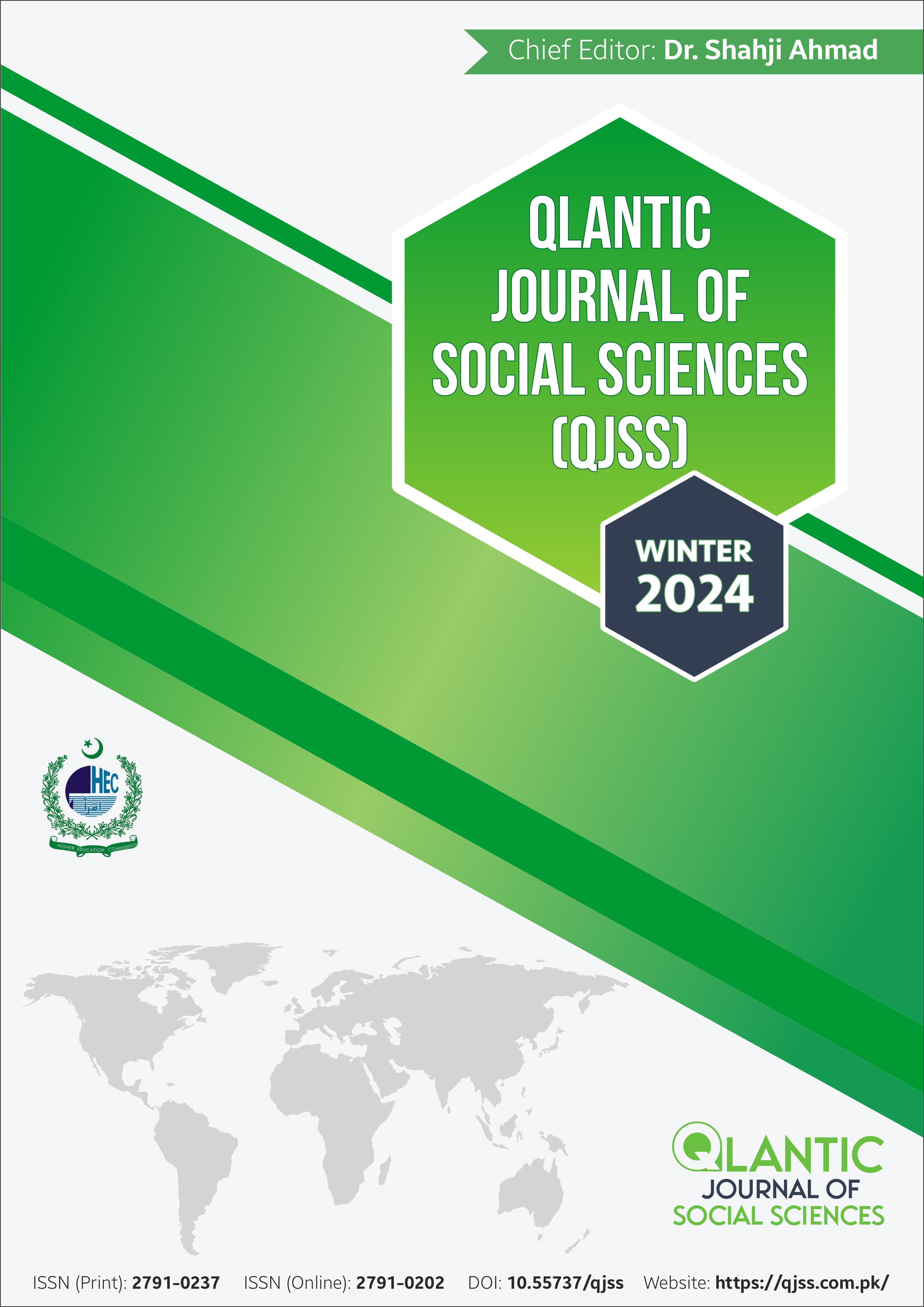Prevalence of Intimate Partner Violence in the Muslim Community of Pakistan and the Fundamental Religious Perspective of Islām (Sharī‘ah)
DOI:
https://doi.org/10.55737/qjss.317943363Keywords:
Intimate Partner Violence, Emotional Abuse, Interpersonal Relationship, Sharī‘ah, PakistanAbstract
This paper explores the prevalence of Intimate Partner Violence, especially emotional abuse, in Pakistan and discusses the fundamental religious perspective of Islām (Sharī‘ah). The dominance, control, isolation, and harassment in intimate relations for degrading purposes are all examples of emotional abuse. The impact of emotional abuse on the relationship between spouses is long-lasting and ranges from physical health to mental health and other social relations of the victim. This study explores various forms of emotional abuse prevailing in Pakistani society. Furthermore, it also discusses possible solutions for offenders of emotional abuse in the light of the Islamic perspective. A mixed-method research methodology is used in the current study. Firstly, the prevalence of emotional abuse is studied by conducting an online survey, and then content analysis of the Islāmic perspective on emotional abuse is discussed. This phenomenon is prevailing in Pakistani society, although Islām protects the rights of partners and discourages any type of violence in interpersonal relationships, including intimate partners.
References
Abrahams et al. (2006). “Intimate Partner Violence: Prevalence and Risk Factors for Men in Cape Town, South Africa.” Violence and Victims, 21(2&1), 247–264. https://doi.org/10.1891/088667006780644271. Accessed 5 May 2019.
Abu Abdullah Al-Qurtubi, Al jami'Al Akham ul Qur’ān . ( Lahore: Zia ul The Holy Qur’ān publications,2012), Vol .9,279.
Ahmad, Bayan ul Qur’ān , Vol.2, 65.
Ahsan, M. M. (1979). The Islāmic Attitude to Social Relations in the Light of Sura Al-Hujurat, Verses 10-12 (Islāmic Foundation,1979,1-2
Ali, P. A., & Irma, M. (2008). Violence against women in Pakistan: a framework for analysis. PubMed, 58(4), 198–203.
Amin Ahsan Islahai,Taddabur-e- Qur’ān (Lahore:Faran Foundations,1991), Vol. 7, 480
Bani, L. M., & Hamza, A. (2015). “The Role of Spouses under Islāmic Family Law,” International Affairs and Global Strategy, 37, 110-111. https://core.ac.uk/download/pdf/234670779.pdf
Domestic Violence Bill (Prevention and Protection), (2021), https://senate.gov.pk/uploads/documents/1623998886_516.pdf
DPA International, (2020, May 13). Pakistan Lockdown triggers a massive surge in violence against women.
Fikree, F. F., & Bhatti, L. I. (1991). “Domestic violence and health of Pakistani women,” International Journal of Gynaecol Obstet 65, 195-201.
Follingstad, D. R., Rutledge, L. L., Berg, B. J., Hause, E. S., & Polek, D. S. (1990). The role of emotional abuse in physically abusive relationships. Journal of Family Violence, 5(2), 107-120. https://doi.org/10.1007/bf00978514
Hussain, S. (2010). “Psychiatric Morbidity in Infertile Pakistani Women: A Systematic Review,” J Pak Psych Soc, 7(2010), 61-66. http://www.jpps.com.pk/article/psychiatricmorbidityininfertilepakistaniwomenasystematicreview_2405.html
Ibn Kathir, Tafsir Ibn Kathir (Riyad:Dar-us-salam,2003),Vol.2, 245
Ibn Kathir, Tafsir Ibn Kathir, Vol 9 , 200
Iqbal, M., & Fatmi, Z. (2018). “Prevalence of Emotional and Physical Intimate Partner Violence Among Married Women in Pakistan,” Journal of Interpersonal Violence 36(9 & 10), 5000. https://doi.org/10.1177/0886260518796523
Israr Ahmad, Bayan ul Quran (Peshawar: Anjman Khudam al-Qur’ān,2019), Vol 4, 313
Karmaliani, R., Pasha, MA, A., Hirani, MScN, S., Somani, MScN, R., Hirani, MScN, S., Asad, N., Cassum, BScN, RN, L., & McFarlane, DrPH, FAAN, J. (2012). Violence against Women in Pakistan: Contributing Factors and New Interventions. Issues in Mental Health Nursing, 33(12), 820–826. https://doi.org/10.3109/01612840.2012.718046
Krug, E. G., Mercy, J. A., Dahlberg, L. L., & Zwi, A. B. (2002). The world report on violence and health. The Lancet, 360(9339), 1083–1088. https://doi.org/10.1016/s0140-6736(02)11133-0
Maria, A., & Pico-Alfonso. (2004). Psychological intimate partner violence: The major predictor of posttraumatic stress disorder in abused women. Neuroscience and Biobehavioral Reviews, 29(1), 181–193. https://doi.org/10.1016/j.neubiorev.2004.08.010
Minhaj-ud-Din Minā’I, Islāmi Fiqah (Lahore: Islāmic Publications Private Limited, 2002),401
Muhammad Ameen AshShaheer, Radd ul Muhtar (Riyad:Dar ul-‘Alimul Kitab,2003), Vol .3, 599-600
Muhammad Shafi, Maarif-ul-Qur’ān (Karachi: Maktaba Darul-Uloom Publisher, 1998) Vol.2, 424.
O’Leary, K. D. (1999). Psychological abuse: A variable deserving critical attention in domestic violence. Violence and Victims, 14(1), 3-23. https://doi.org/10.1891/0886-6708.14.1.3
Qutb, In the shade of The Holy Qur’ān ,Vol. 3,66
Qutb, In the shade of The Qur’ān ,Vol 15, 520
Qutb, In the shade of the Qur’ān, Vol.1, 324.
Qutb, S. (2003). In the shade of The Holy Qur’ān, Translated by MA Salahi (Leicester: The Islāmic Foundation , Vol. 15,126
Rehman, A. (1991). Role of Muslim Women in Society (Chicago: Kazi Publications,), 49
Riyad as-Ṣāliḥin, 254: 1555
Sahih al-Bukhari, 23: 6478
Saḥiḥ al-Bukhāri, 76: 6114
Sahih Muslim, 9: 2563
Sunan Abi Dawud, 131: 5146
Sunan an-Nasā'i,76: 2391
Sunan Ibn Mājah, 12: 3973
The Holy Qur’ān , Al-Baqarah:226-227
The Holy Qur’ān , An-Nisā’:19
The Holy Qur’ān , An-Nisā’:34
The Holy Qur’ān ,Al-Mujādilah: 1
The Holy Qur’ān ,Al-Mujādilah: 3
The Holy Qur’ān, Al-Isra:53.
The Holy Qur’ān, Al-Ḥujurat:12
The Holy Qur’ān, Qaf:18
The Holy Qur’ān,Āl-i-Imrān:134
The Holy Qur'ān, An-Nahl:58-59




